Public Sentiment on Decriminalising Abortion

Article byIDEA Research TeamPublished on Mon Dec 19 202216 minute read
Executive Summary
This survey, presented by Malta Survey, assesses the public's sentiment towards the proposed clause to decriminalise the termination of pregnancy in the cases where there exists a risk towards the pregnant woman's life and/or physical health. The findings of this survey include the following:
- There is a strong sentiment towards allowing the decriminalisation of abortion in the cases of risk towards the pregnant woman's health and/or life;
- There is a favourable sentiment towards allowing the decriminalisation of abortion in the cases of incest and/or rape;
- There is a negative sentiment towards allowing the decriminalisation of abortion in the cases of the pregnant woman facing mental health problems and any economic issues;
- There is a majority sentiment towards no referendum being required on the matter; and
- There is a majority sentiment that such a matter should involve both genders' viewpoints.
Introduction
Later today (Monday 19th December 2022), Parliament is expected to vote on a second reading of Bill 28 of the Fourteenth Legislature. This amendment discusses the introduction of a clause to the criminal code, challenging the points where abortion can be decriminalised. As stated by Parliament, "the objects and reasons of this Bill are to provide clarification on the parameters that shall apply in the Criminal Code (Cap. 9) to circumstances of necessity in which a medical intervention is required in order to protect the life and health of pregnant woman suffering from a medical complication".
Maltasurvey.com powered by IDEA Intelligence which is part of IDEA Group is a public space where citizens can freely and voluntarily voice their concern on different topics. This is site is completely independent from any political party and media organisation. Our aim is to use this platform to bring to the fore general ideas and perceptions and evaluate the responses in line with the current trends.
This survey is divided into two major sections. In the first section, an investigation on the public’s perceptions towards the decriminalisation of abortion in different cases is carried out. The second section casts observations on the sentiment towards the process of the amendment itself.
Methodology
Data Gathering & Analysis
The online survey was carried out between the 13th and the 17th of December 2022. An online invitation was sent on social media platforms and all participants opted to voice their opinion voluntarily.
Throughout the data gathering process, full anonymity was ensured by not requiring any identity related details to complete the survey and not using any cookies to personalise the information presented. Any e-mail addresses submitted by the participants was optional and for the purpose of getting the link to this report upon its publishing. No e-mail data was used for the analysis phase. The investigation and analysis was done using Data Science tools including Python, Julia and Jupyter Notebooks.
Margin of Error
As at 31st December 2021, according to the NSO's regional statistics document, Malta had a total population of 516,000. After removing the first age decile demographic (0-9 year olds) so as to start counting from the population that is both relevant to be sexually active and included in the case of a referendum, the total target population is that of 468,817. With a sample size of 1,383 participants, the findings mentioned below have a margin of error of 3% at a 95% confidence level.
Analysis
Part 1: Demographic analysis of the sample
The sample consists of 1,383 participants composed of 61.5% females and 36.4% males and 1.2% with non-binary gender as portrayed in Figure 1 below.

The survey mostly attracted participants between 18 and 40 years of age in terms of concentration. In addition, there is somewhat equal participants amongst participants that are over 60 years of age and those aged between 41 and 50 years of age. One can interpret the majority contribution as those facing the clause presented by this amendment directly. The reason for this is that if one is to have a child, a high chance of this happening is between the ages of 18 and 40.
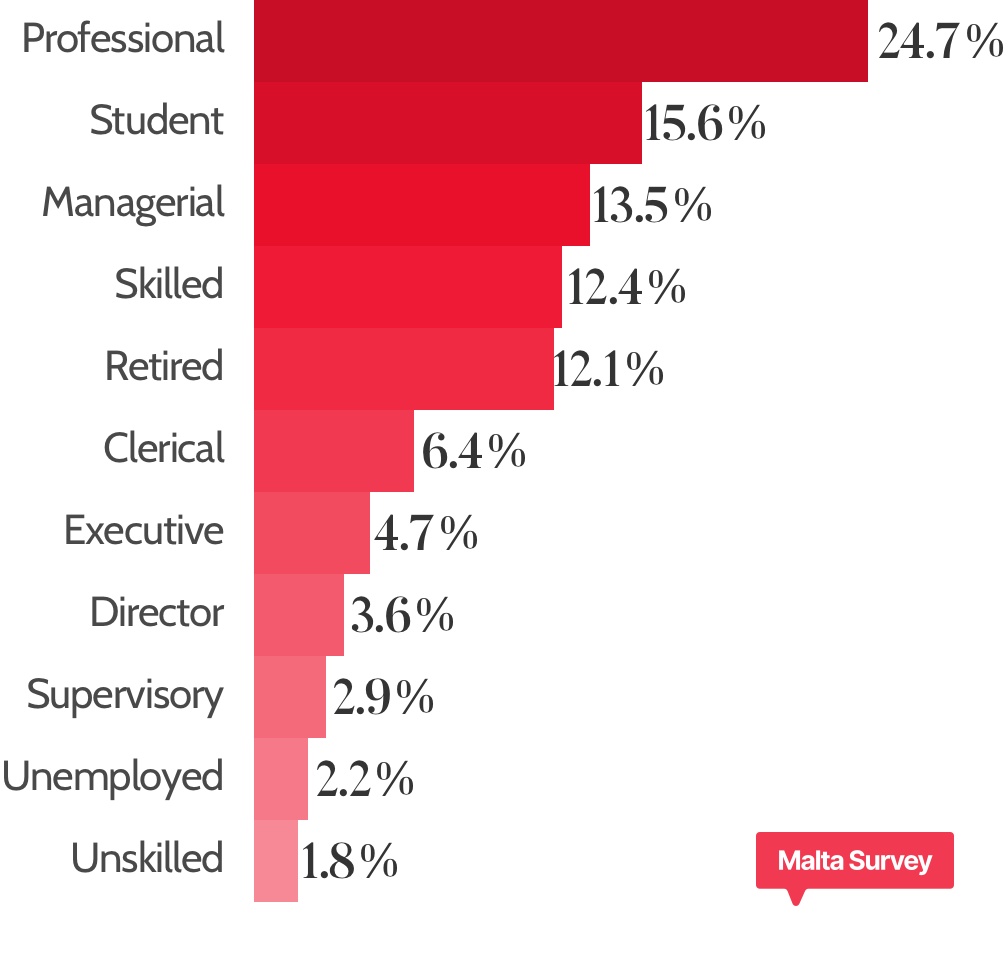
When assessing the breakdown of the occupational roles of the participants of this sample, one can observe how a quarter of the sample is made up of professionals whilst the other four most popular groups are students, managers, skilled professional and those that are retired. This can provide a healthy mixture to the results discussed in the next section of this report as it feeds from the national workforce in Malta and Gozo, the student base, and the pensioners altogether.

The distribution of education levels comprised in this sample shows that more than half of the participants have at least one degree (Bachelor’s Degree, Master’s Degree, Doctoral Degree and Post-Graduate Diploma). Such an observation further improves the validity of this sample as it shows an educated portion of people’s opinions on such a delicate and sensitive topic.

There is a complement with the average income figures previously exhibited here. Furthermore, despite a female majority participation in this sample, the only areas where there are more male participants is in the income brackets of more than €50,000.
Part 2: The sentiment on Abortion & the proposed amendment
This sections addresses the following two major questions:
1. At what point are the people ready for abortion to be decriminalised?
2. How do the people want Bill 28 to be settled?
Question 1: At what point are the people ready for abortion to be decriminalised?
In order to gain a better understanding of people’s perception on what they consider an acceptable condition for abortion to be decriminalised, it was opted not to use a basic “Yes or No” question. Rather, the following five cases that are directly or indirectly relatable to the proposed amendment were taken into consideration:
- The case of the pregnant woman’s life being at risk;
- The case of the pregnant woman’s physical health being at risk at a non-fatal condition;
- The case of the pregnant woman’s mental health being at risk at a non-fatal condition;
- The case of the pregnant woman being the victim of rape and/or incest; and
- The case of economic difficulty.
Furthermore, for every case, a mutually exclusive decision was given to the participant to take in the form of the following choices:
- Yes, allow abortion at any stage during the pregnancy;
- Yes, allow abortion up to 24 weeks of pregnancy;
- Yes, allow abortion up to 12 weeks of pregnancy;
- Never allow abortion; and
- I’m not sure.
Based on that, the following results were observed.
Assessing Cases 1 and 2 - ones with direct reference to Bill 28's proposal.
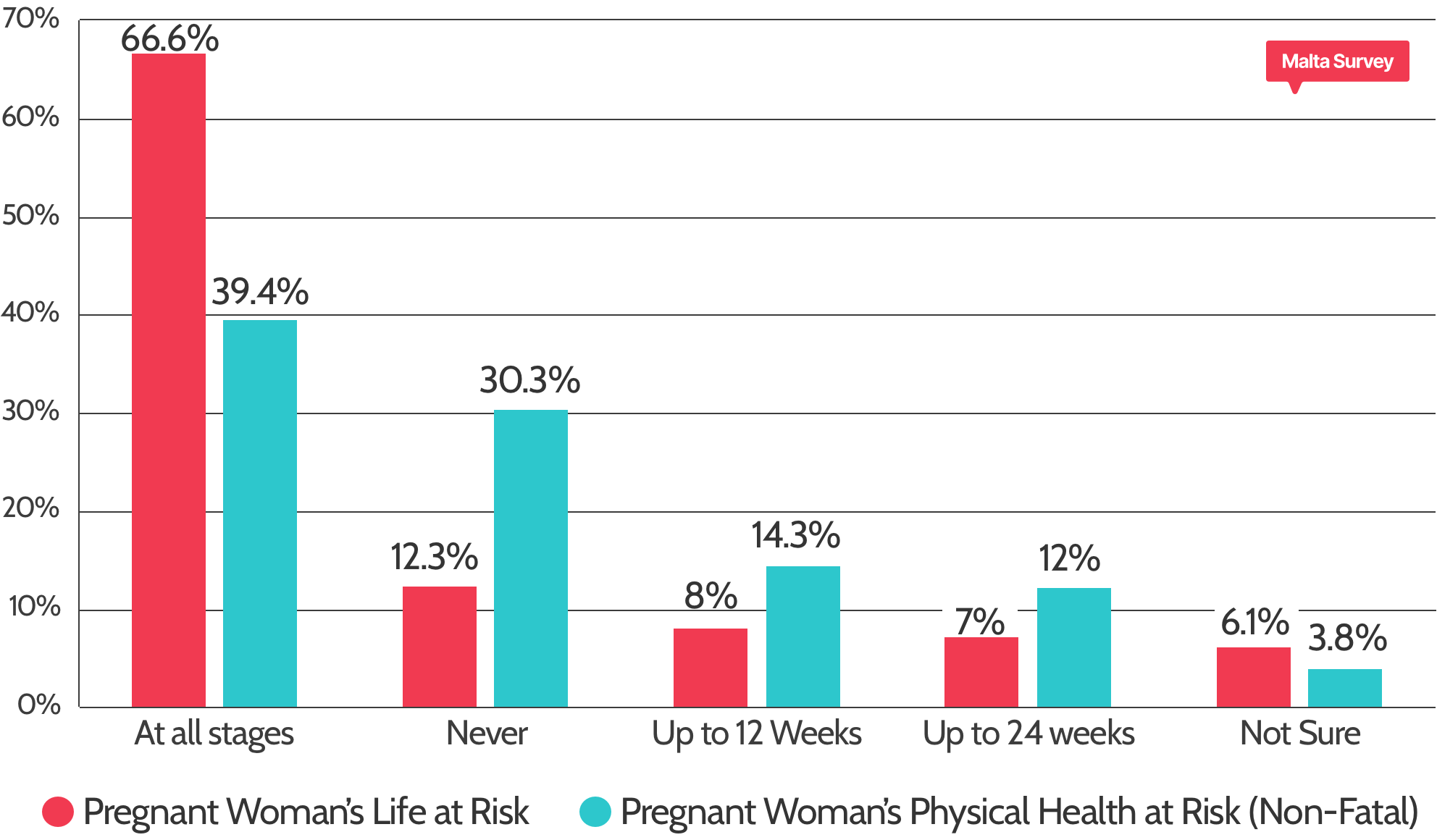
The results clearly show the majority is ready to accept the decriminalisation of abortion whenever the pregnant woman’s life is at risk or her physical health is at risk (even in a non-fatal condition). Furthermore, this acceptance is ready to be made during any stage of the pregnancy rather than having it only up to a particular stop date. This shows that the public is not ready to risk the loss of life of any pregnant woman or allow any detriment to her physical health.
The next most popular sentiment in this is dominated by those who would not allow abortion at any stage of the pregnancy even in the case that there is a risk towards the pregnant woman’s life or her physical health. This shows a jump in the polarity of the sentiment towards this decriminalisation from allowing it at any stage to not allowing it at all. In terms of those preferring a middle ground approach, the most common sentiment is to allow such a medical procedure to be done early on with a cut-off date set to the first 12 weeks, after which there is the smaller group of participants who are ready to decriminalise abortion up to the later stage of 24 weeks of pregnancy. The smallest group in both of these 2 cases comprises the people who are unsure of which position to take at this point.
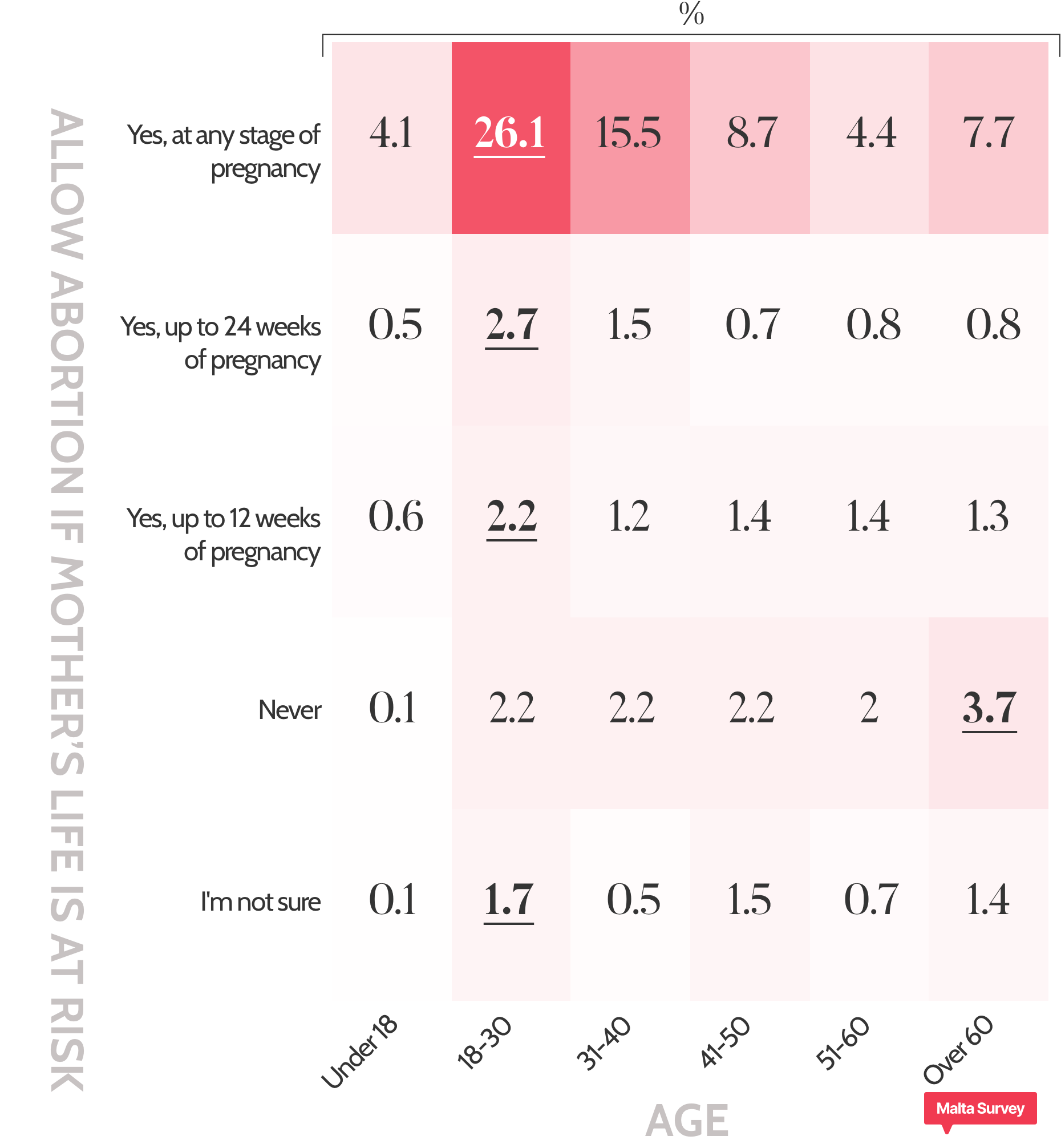
In order to better understand the demographics contributing to the sentiments, if one splits the results of Case 1 by age, it can be observed that the choice to allow the termination of pregnancy during any stage of the pregnancy if there is a risk towards the mother’s life is presented through all age deciles in this sample.
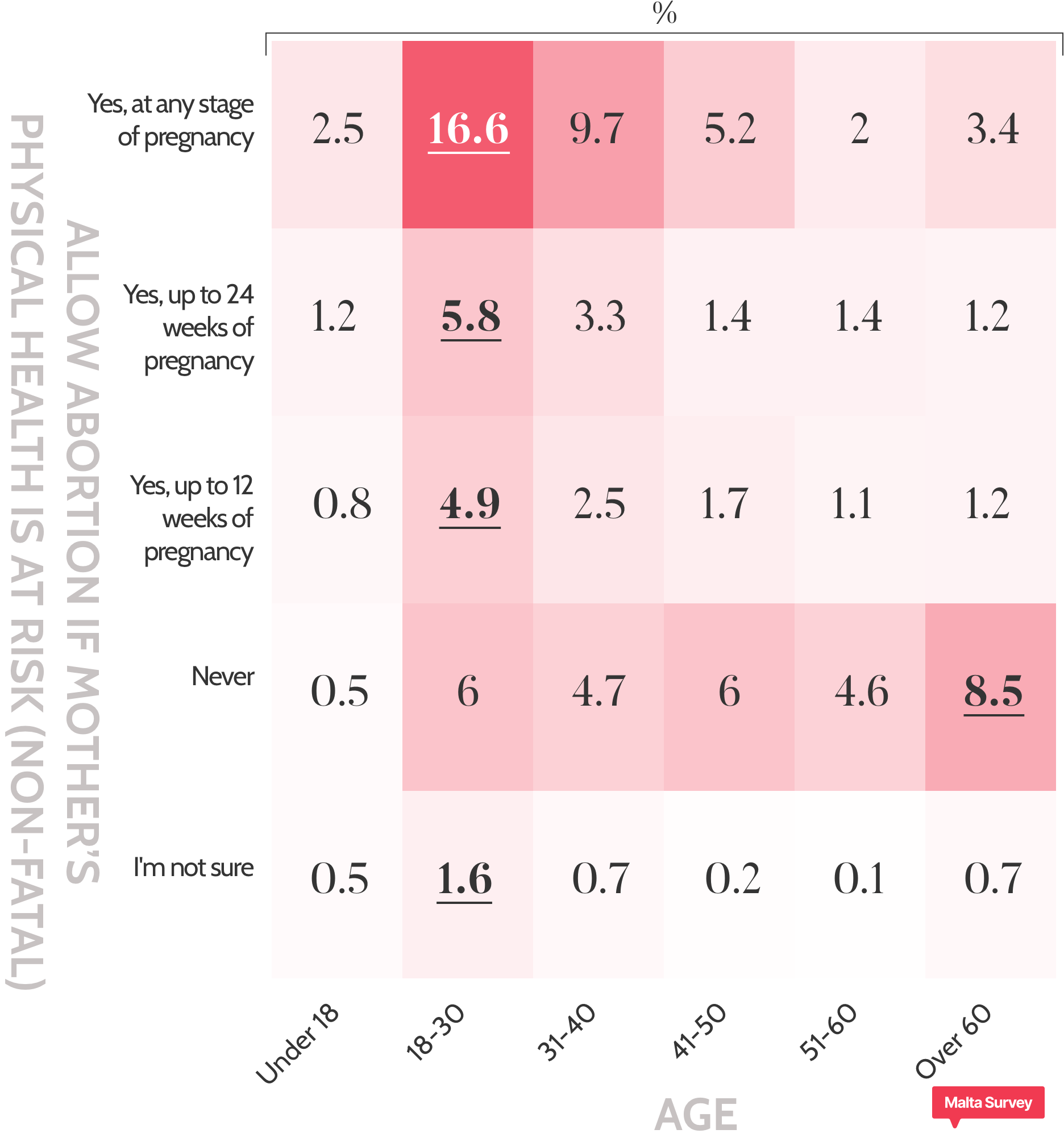
When observing the distribution of Case 2 by age, one can notice how the highest concentration of the fold comes from those allowing termination of pregnancy at any stage and are aged between 18-30. The next biggest subgroup is comprised of those with the same opinion but are of the age between 31 and 40. However, the most popular subgroup of people with the opinion of never allowing termination of pregnancy to occur are more than 60 years old.
Assessing the three cases not directly related to Bill 28.
As Bill 28 directly specifies the cases considered as being the risk of life and/or physical health of the pregnant woman, the following three cases cannot be considered to be part of its remit (to our knowledge as at the writing of these findings).
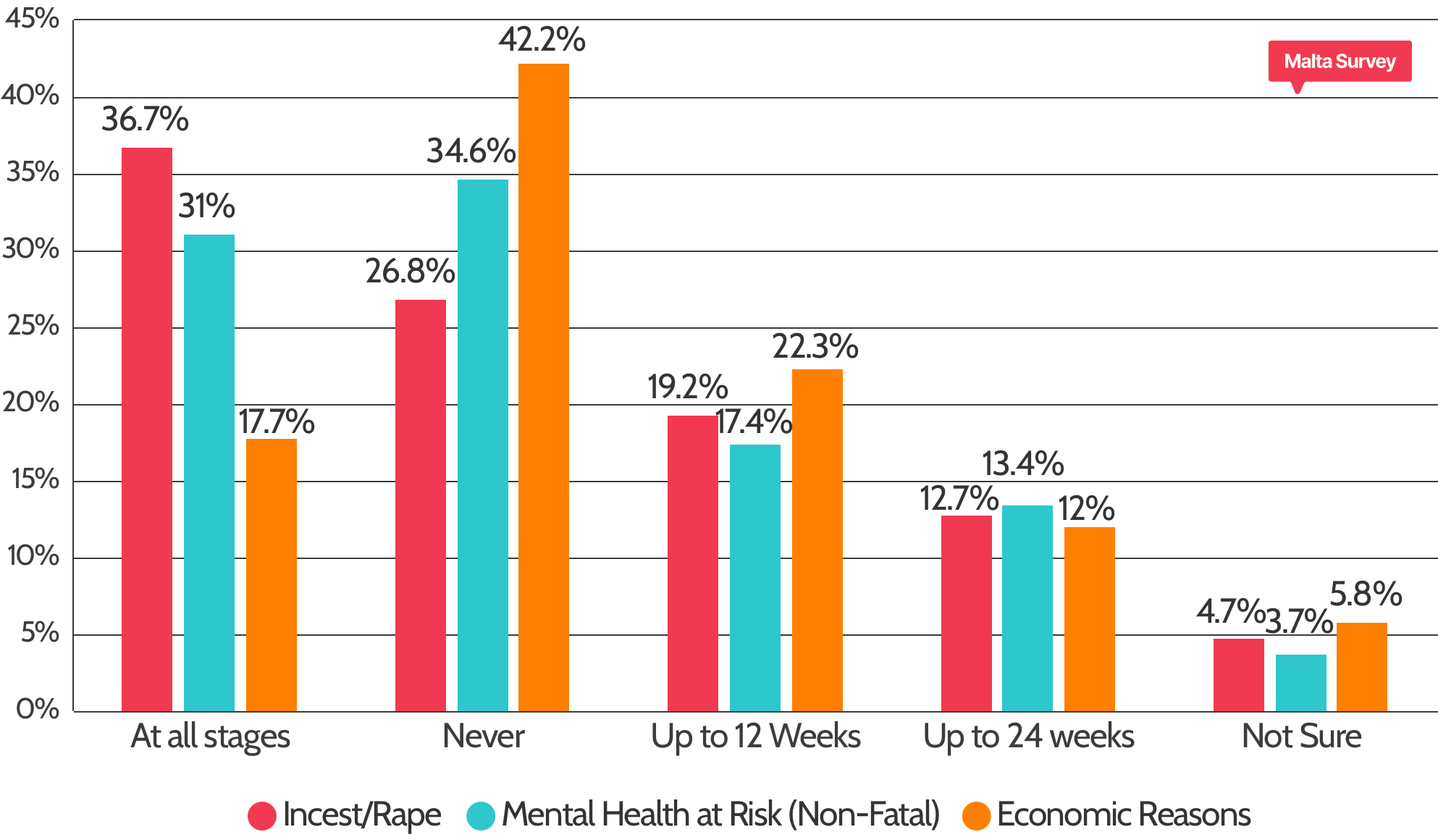
In the case of the pregnant woman being a victim of incest and/or rape, the majority sentiment is similar to the cases of that woman’s life or health being at risk. Termination of pregnancy in that case can be allowed at all stages of the pregnancy according to the majority of our sample. In a similar fashion, the next most popular sentiment is the polar opposite opinion – that of not allowing termination of pregnancy to happen during at any stage of the pregnancy. Furthermore, those participants that were not ready to take the final stance towards any direction of the scale were ready to allow a termination of pregnancy with a duration of up to 12 weeks followed by 24 weeks. Once more, the smallest group comprised the ones without a stance yet.
On the other hand, when discussing the issue of the pregnant woman’s mental health and economic difficulty being the reason for the termination of pregnancy, the most popular sentiment was never to allow the abortion to happen during any stage of the pregnancy. In the case of mental health, the 2nd most popular group was that allowing the termination to happen during any stage of the pregnancy, with a similar pattern as observed before occurring with the final three groups of acceptance.
In the case of economic reasons however, the second most popular group was that where the pregnancy would only be allowed within the first 12 weeks. The sentiment to allow the termination during any stage of the pregnancy was the third most common in the case of economic reasons, followed by those allowing it within 24 weeks and the uncertain ones.
When assessing these 5 cases together, one can notice how there is an “always vs never” clash occurring. The cases where the sentiment is to allow termination of the pregnancy during any stage are ones where the woman’s life, physical health or consent are at risk. On the other hand, the most popular sentiment when the woman’s mental health or economic condition is the case is that of not to allow abortion during any stage of the pregnancy.
Question 2: How do the people want Bill 28 to be settled?
For the sake of clarity, this survey separated the participants’ opinion about how acceptable they are of abortion itself from their opinion on how Bill 28’s proposed amendment in particular should be carried out.
Assessing the population’s awareness on Bill 28’s proposed amendment.
In order to better understand whether or not the participants’ opinion on abortion featured previously can be justified as to how educated they are on the amendment itself, we assess whether or not they are aware of the discussions that were being hosted in Parliament across the previous days as well as the objectives of the amendment.

On the onset, most of the participants (almost all of them) were aware of the discussion occurring in Parliament.
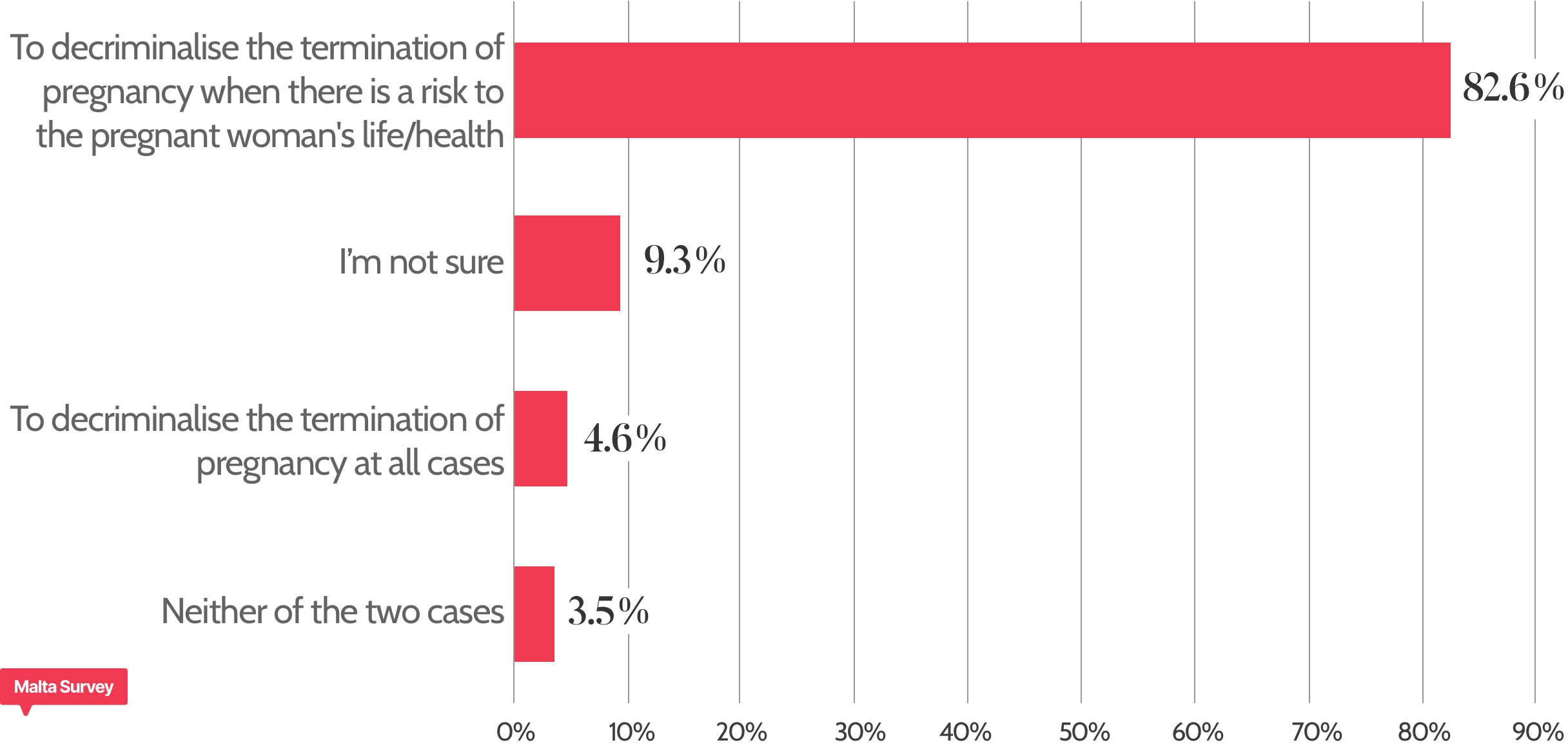
Furthermore, not only are the participants aware of the discussions occurring on the amendment, but their knowledge on the proposals being brought forward in through the clause is accurate in the majority. With that being said, a total of 18.2% of inaccuracies of a clause of this nature cannot be considered to be a small occurrence that can be ignored.
Assessing the population’s preference on how Bill 28 should be settled.
The next question to assess was whether the participants wanted a debate of this nature to be left to the electorate to settle over a referendum rather than allow Parliament to see it through.
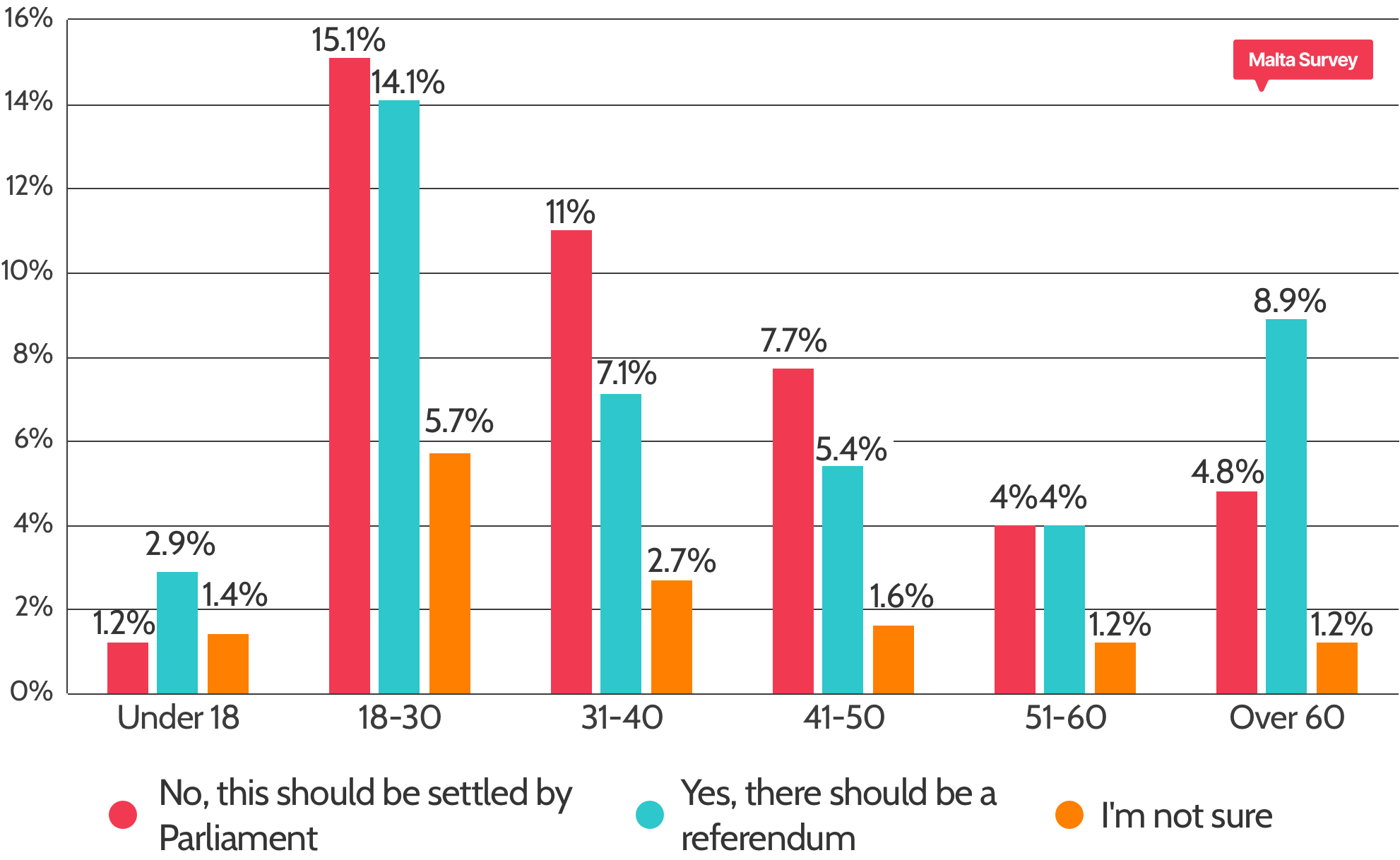
The highest proportions of opinions by age show how the participants prefer Parliament to settle whether Bill 28’s amendment clause will pass or not. It is only people that are aged below 18 or over 60 that have a majority preference towards a referendum taking place on this matter. The total population of participants that want a referendum is 42.4% whereas those that do not want a referendum to happen make up 43.7% of the sample. Furthermore, there is a slight sentiment of uncertainty on the referendum matter (a total of 13.9%), throughout all age groups.
The final question was to assess the genders that should be making such a decision on whether this amendment goes through.

It can be observed how a strong majority of the participants prefer that both genders are involved in the final say of this proposed clause’s motion. As one can expect with a matter directly treating the health and condition of a female, there was a strong sentiment of the female participants that preferred it to be a female decision to be had. Finally, as expected once more, a negligible portion prefer it to be a male driven decision.
Conclusion
There is no question that this is one of the more sensitive topics that the country has seen in a significant time. As a result, it is important that when presenting results of this sort one be as objective as possible whilst respecting the fact that behind statistics, there are personal lives and stories. The observations made in this report show that such a discussion is not a matter of "Yes" vs "No". On the contrary, the evidence shows that there are conditions that affect one's decision on the matter and even that decision has its own thresholds. The Malta Survey team aims to bring these results to the fold with the purpose of making decision makers and the public aware of where we currently stand as a population; they are meant to be used as part of the ongoing discussion with the scope of providing the greater good for the nation.


